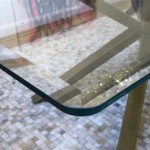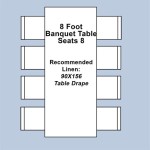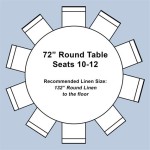Table Decorating Ideas For Dinner Parties
The ambiance of a dinner party plays a significant role in enhancing the overall experience. The table setting is a crucial element that contributes to this ambiance, influencing the mood and atmosphere of the event. Thoughtful table decorating can elevate a simple meal into a memorable occasion, showcasing the host's attention to detail and creating a welcoming and aesthetically pleasing environment for guests.
Effective table decorating involves a harmonious blend of various components, including linens, centerpieces, tableware, and lighting. The selection and arrangement of these elements should reflect the theme of the dinner party, the season, and the host's personal style. A well-decorated table demonstrates consideration for guests and contributes to a more enjoyable and engaging dining experience.
Selecting a Color Palette and Theme
Choosing a color palette is the foundational step in table decorating. The color scheme dictates the overall mood and sets the tone for the entire event. Consider the occasion and desired atmosphere when selecting colors. For instance, a formal dinner party might benefit from a sophisticated palette of silvers, golds, and deep jewel tones, while a casual gathering could embrace brighter, more playful hues.
The theme of the dinner party should also influence the color selection. A rustic theme could incorporate earthy tones like browns, greens, and creams. A nautical theme could lean towards blues, whites, and sand colors. The color palette should extend to linens, tableware, and floral arrangements to create a cohesive and visually appealing aesthetic. Understanding the principles of color theory, such as complementary or analogous color schemes, can be helpful in creating a visually balanced and harmonious table setting.
Beyond the basic color selection lies the importance of texture. Incorporating different textures, such as smooth satin linens contrasted with rough-hewn wooden elements, adds depth and complexity to the table setting. This variation in texture can make the tablescape more engaging and visually stimulating. Metallic accents can also be incorporated to add a touch of glamour and sophistication, but it is crucial to use them sparingly to avoid overwhelming the overall design.
Consider the existing décor of the dining room when choosing a color palette. The table setting should complement the surrounding environment rather than clash with it. If the dining room has a neutral color scheme, the table setting can be used to introduce pops of color. Conversely, if the dining room is already colorful, a more subdued table setting might be more appropriate.
Creating a Memorable Centerpiece
The centerpiece is the focal point of the table and plays a crucial role in creating a visually striking and memorable dining experience. A well-chosen centerpiece can elevate the entire table setting and serve as a conversation starter. The size and scale of the centerpiece should be appropriate for the size of the table, ensuring that it does not obstruct the view of guests or hinder conversation.
Floral arrangements are a classic centerpiece option, offering a wide range of styles and color combinations to suit any theme. Consider the season when selecting flowers. Spring and summer events can feature vibrant blooms like tulips, roses, and hydrangeas, while autumn and winter gatherings might benefit from richer, deeper colors and textures, such as berries, branches, and pinecones. The height of the floral arrangement is critical; it should be low enough to allow guests to see each other across the table.
Beyond floral arrangements, alternative centerpiece ideas can add a unique and personal touch to the table setting. Candle arrangements, particularly those with varying heights and styles, can create a warm and inviting ambiance. Consider using candelabras, votive candles, or pillar candles in glass holders to add visual interest. Natural elements, such as driftwood, stones, or shells, can be incorporated into a centerpiece to create a rustic or coastal theme.
For more modern and minimalist settings, consider using geometric shapes, sculptures, or abstract art pieces as the centerpiece. These elements can add a touch of sophistication and create a visually striking focal point. Always ensure that the centerpiece complements the overall theme and color palette of the table setting. Personalizing the centerpiece with items that reflect the host's interests or hobbies can add a unique and memorable touch to the dinner party.
Consider the practical aspects of the centerpiece as well. If serving food family-style, ensure that there is enough space on the table for serving dishes. A centerpiece that is too large or cumbersome can make it difficult for guests to reach food and interact with each other. A well-designed centerpiece is both visually appealing and functionally practical.
Selecting Tableware and Linens
The choice of tableware and linens is essential for creating a cohesive and elegant table setting. The style of tableware should complement the theme of the dinner party and the type of cuisine being served. Formal occasions might call for fine china and crystal glassware, while casual gatherings could utilize more relaxed and informal tableware options.
The selection of linens, including tablecloths, napkins, and placemats, plays a significant role in defining the overall aesthetic of the table. A crisp, white tablecloth can create a clean and sophisticated backdrop for any table setting. Alternatively, colored or patterned tablecloths can add visual interest and personality. Napkins can be folded in various ways to add a touch of elegance and sophistication. Consider using napkin rings to add a decorative element.
The arrangement of tableware should follow proper etiquette guidelines. The placement of forks, knives, and spoons should be intuitive and easy for guests to understand. The placement of glassware should also be considered, with water glasses typically placed above the knife and wine glasses positioned to the right. A well-set table demonstrates attention to detail and respect for guests.
Consider the materials of the tableware and linens. High-quality materials, such as linen and fine china, can elevate the overall dining experience. However, more affordable options, such as cotton and durable stoneware, can also be used effectively, particularly for casual gatherings. The key is to choose materials that are both aesthetically pleasing and practical for the occasion.
Pay attention to the details of the tableware and linens, such as the shape of the plates, the design of the silverware, and the texture of the napkins. These small details can contribute to the overall impression of the table setting. Mixing and matching different patterns and textures can create a more eclectic and visually interesting look, but it is important to ensure that the overall design remains cohesive and harmonious.
For outdoor dinner parties, consider using durable and weather-resistant tableware and linens. Melamine plates and acrylic glassware are good options for outdoor settings. Use tablecloth weights to prevent the tablecloth from blowing away in the wind. The goal is to create a table setting that is both beautiful and functional, ensuring that guests can enjoy their meal in comfort and style.
Lighting significantly impacts the ambiance of the table setting. Soft, warm lighting can create a romantic and intimate atmosphere, while brighter lighting can be more appropriate for lively and festive gatherings. Candlelight is a classic choice for dinner parties, adding a warm and inviting glow. Consider using a combination of candlelight and ambient lighting to create a balanced and visually appealing effect.
String lights can also be used to add a touch of whimsy and charm to the table setting, particularly for outdoor dinner parties. The color and intensity of the lighting should be carefully considered to create the desired mood. Avoid harsh or overly bright lighting, which can be unflattering and uncomfortable for guests. The goal is to create a lighting scheme that enhances the overall dining experience and makes guests feel comfortable and relaxed.
Personalized touches can elevate the table setting and make guests feel special. Consider adding place cards with each guest's name, handwritten menus, or small favors as a gesture of appreciation. These personalized elements demonstrate thoughtfulness and attention to detail, making the dinner party more memorable and enjoyable for everyone involved.
Overall, successful table decorating involves careful planning and attention to detail. By selecting a cohesive color palette and theme, creating a memorable centerpiece, choosing appropriate tableware and linens, and paying attention to lighting and personalized touches, one can elevate the dining experience and create a welcoming and aesthetically pleasing environment for guests.

Lovely Outdoor Table Decor For A Dinner Al Fresco Party Settings

Fall Dinner Party Tablescape And Menu Ideas Modern Glam

Beautiful Table Settings For Any Party

Spring Outdoor Table Ideas Hallstrom Home

40 Table Decoration Ideas 2024 Chic Easy Tablescape

Fall Dinner Party Menu The Best Ideas For Friendsgiving Thanksgiving Table Settings Rustic

Fall Table Decor Ideas

The Best Dinner Party Decor Guide Decoration Ideas

Party Centerpieces

Dinner Party Ideas








